2010 December 9
2nd Annual Retrofitting & Planning Sustainable Suburbs Summit
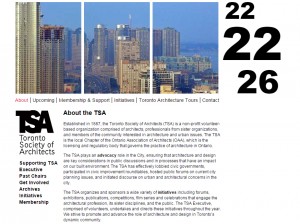
Events 0

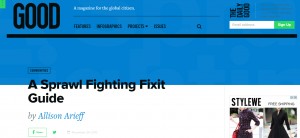
In Arcade Fire’s latest video, The Suburbs, the dystopic view of suburbia takes over as a militia moves in to transform a gated community in a police state. SWAT teams forcibly remove parents and their 2.2 kids from their homes while stunned adolescents, returning from an idyllic afternoon of bicycling around cul de sacs, and shooting BB guns from overpasses, watch in horror as their neighborhood is taken over.
Galina Tachieva, author of The Sprawl Repair Manual, would agree with the Canadian indie rockers that the suburbs are in dire straits. But her vision is less cinematic, more pragmatic. Tachieva’s timely guide proposes specific design solutions to retrofit existing conditions—not simple, not inexpensive, but imperative.

Incorporate multifamily housing into the fabric of malfunctioning suburbs–or the Boomers and Echo Boomers will move out, says Galina Tachieva, partner and director of town planning at Duany Plater-Zyberk & Company (DPZ). Tachieva describes the ways in which the burden rests on multifamily developers to play a leading role this century in reclaiming the sprawl-marred suburbs. “It is no surprise that numerous sprawl developments, particularly those in the far-flung exurbs, have recently suffered some of the highest rates of foreclosure. Many homes, and even entire subdivisions, have been abandoned,” says Tachieva, in an interview with MHN.
“Almost all idiosyncratic sprawl types will benefit radically from introducing multifamily development,” according to Tachieva, and she outlines the ways in which multifamily developers can accomplish the goal of redesigning these communities. An expert on transforming sprawl developments into human-scale, sustainable communities, Tachieva is the author of the just-released Sprawl Repair Manual (Island Press).
The transit-oriented, high-density town center will be used by the surrounding communities.
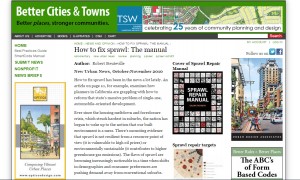
How to fix sprawl has been in the news a lot lately. An article on page 10, for example, examines how planners in California are grappling with how to reform that state’s massive problem of single-use, automobile-oriented development.
Ever since the housing meltdown and foreclosure crisis, which struck hardest in suburbs, the nation has begun to wake up to the notion that our built environment is a mess. There’s mounting evidence that sprawl is not resilient from a resource point of view (it is vulnerable to high oil prices) or environmentally sustainable (it contributes to higher greenhouse gas emissions). The flaws of sprawl are becoming increasingly noticeable in a time when shifts in demographics and consumer preferences are pushing demand away from conventional suburbs.
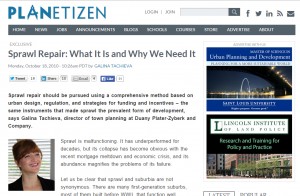
Sprawl is malfunctioning. It has underperformed for decades, but its collapse has become obvious with the recent mortgage meltdown and economic crisis, and its abundance magnifies the problems of its failure.
Let us be clear that sprawl and suburbia are not synonymous. There are many first-generation suburbs, most of them built before WWII, that function well, primarily because they are compact, walkable, and have a mix of uses. Sprawl, on the other hand, is characterized by auto-dependence and separation of uses. It is typically found in suburban areas, but it also affects the urban parts of our cities and towns.
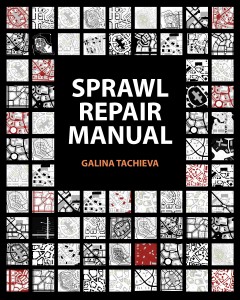
The Sprawl Repair Manual presents a comprehensive methodology for transforming sprawl developments into human-scale, sustainable communities. In this richly illustrated book, Galina Tachieva draws on more than two decades of experience to provide a step-by-step process of design, regulatory, and implementation techniques for reurbanizing and rebalancing suburbia.
Her solutions will inspire and equip anyone looking to reimagine suburban development.
The Sprawl Repair Manual is so far the only complete physical planning manual for handling the impending transformation of suburbia into vital human communities. It is not only hugely instructive but formidably inspirational.
—Leon Krier, Master Planner of Prince Charles’ Poundbury Project in Dorset, UK and author of The Architecture of Community
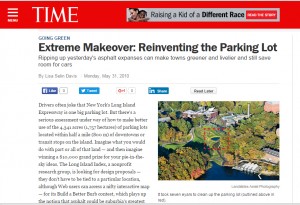
Ripping up yesterday’s asphalt expanses can make towns greener and livelier and still save room for cars
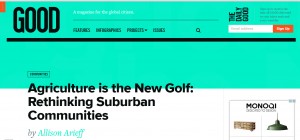
There is new movement to plan suburban communities around farms instead of golf courses. Can it catch on?
It has often been observed that suburbia is a place where the developer displaces animals and rips out trees, and then names the streets after them.
Whether you see that as destruction or reinvention, the tendency is nothing new. All of America was built on this sort of land transformation, some of it smart, much of it not. But the devastation wrought from decades of intervention by heavy equipment has manifested itself in a range of ills from economic collapse to loss of biodiversity. So today we’re faced with a strange scenario: Our relentless pursuit of the American Dream now has us scrambling for a return to Eden.
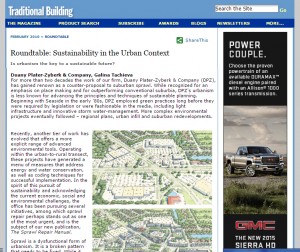
For more than two decades the work of our firm, Duany Plater-Zyberk & Company (DPZ), has gained renown as a counter-proposal to suburban sprawl. While recognized for an emphasis on place making and for outperforming conventional suburbia, DPZ’s urbanism is less known for advancing the principles and techniques of sustainable planning. Beginning with Seaside in the early ’80s, DPZ employed green practices long before they were required by legislation or were fashionable in the media, including light infrastructure and innovative storm water-management. More complex environmental projects eventually followed – regional plans, urban infill and suburban redevelopments.
The pair of aerials demonstrates the transformation of a conventional strip shopping center into a mixed-use, pedestrian-friendly town center that will serve the surrounding suburban communities. The existing big boxes and drive-through restaurants are embedded in fine-grain fabric of urban blocks, centered on a new square.
Recently, another tier of work has evolved that offers a more explicit range of advanced environmental tools. Operating within the urban-to-rural transect, these projects have generated a menu of measures that address energy and water conservation, as well as coding techniques for successful implementation. In the spirit of this pursuit of sustainability and acknowledging the current economic, social and environmental challenges, the office has been pursuing several initiatives, among which sprawl repair perhaps stands out as one of the most urgent, and is the subject of our new publication, The Sprawl Repair Manual.
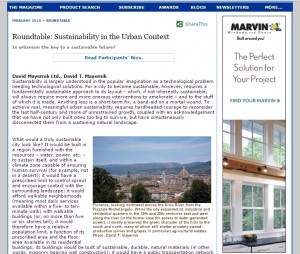
For more than two decades the work of our firm, Duany Plater-Zyberk & Company (DPZ), has gained renown as a counter-proposal to suburban sprawl. While recognized for an emphasis on place making and for outperforming conventional suburbia, DPZ’s urbanism is less known for advancing the principles and techniques of sustainable planning. Beginning with Seaside in the early ’80s, DPZ employed green practices long before they were required by legislation or were fashionable in the media, including light infrastructure and innovative storm water-management. More complex environmental projects eventually followed – regional plans, urban infill and suburban redevelopments.
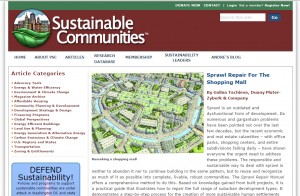
Sprawl is an outdated and dysfunctional form of development. Its numerous and gargantuan problems have been pointed out over the last few decades, but the recent economic and real estate calamities – with office parks, shopping centers, and entire subdivisions failing daily – have shown everyone the urgent need to address these problems. The responsible and sustainable way to deal with sprawl is neither to abandon it nor to continue building in the same pattern, but to reuse and reorganize as much of it as possible into complete, livable, robust communities. The Sprawl Repair Manual offers a comprehensive method to do this. Based on knowledge gained from built projects, it is a practical guide that illustrates how to repair the full range of suburban development types. It demonstrates a step-by-step process for the creation of more sustainable human settlements out of our wasteful sprawling landscape. This is a framework for designing the interventions, incorporating them into the regulatory system, and implementing them with permitting strategies and financial incentives.
Below is an edited excerpt from the Sprawl Repair Manual that demonstrates the transformations of one of the most typical and promising contenders for sprawl repair, the shopping mall. (Analysis of the region and the site’s immediate context, as well as urban design, zoning and implementation techniques, are explained in more detail in the book). Because of their location, parcel size, ownership structure, and opportunities for transit and mixed uses, malls have great potential to be transformed into transit-ready urban cores, commonly referred to as town centers.
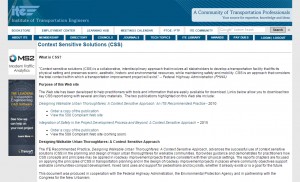
“Context sensitive solutions (CSS) is a collaborative, interdisciplinary approach that involves all stakeholders to develop a transportation facility that fits its physical setting and preserves scenic, aesthetic, historic and environmental resources, while maintaining safety and mobility. CSS is an approach that considers the total context within which a transportation improvement project will exist.” -Federal Highway Administration (FHWA)
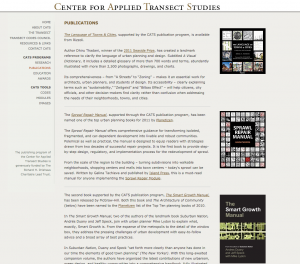
Publications sponsored or supported by the Center for Applied Transect Studies. These publications cover a range of topics concerning traditional urban design, and the repair of sprawl.
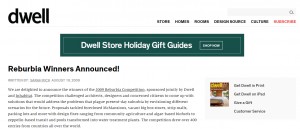
The People’s Choice Award, which was selected through an online voting process that allowed the general public to elect their favorite entry from a list of twenty finalists, was the Urban Sprawl Repair Kit: Repairing the Urban Fabric, submitted by Galina Tahchieva. Capturing over 2300 votes and 188 comments from our passionate online community, this design delineated five building typologies characteristic of suburbia, and corresponding formulas for recreating them in order to promote environmental responsibility and community building.
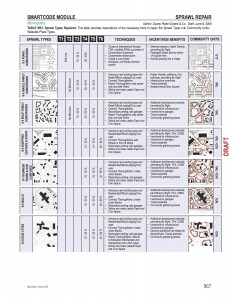
A SmartCode module addressing strategies for the infill of sprawl, including a transect of sprawl types. Repair strategies include overall patterns, street retrofits, and retrofit at the lot and block scale.
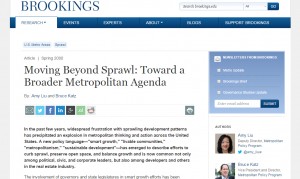
In the past few years, widespread frustration with sprawling development patterns has precipitated an explosion in metropolitan thinking and action across the United States . A new policy language—”smart growth,” “livable communities,” “metropolitanism,” “sustainable development”—has emerged to describe efforts to curb sprawl, preserve open space, and balance growth and is now common not only among political, civic, and corporate leaders, but also among developers and others in the real estate industry.